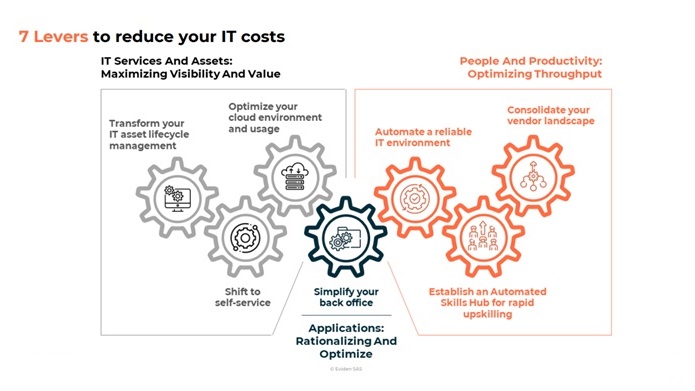In a tough economic climate, cutting IT costs might be necessary – but it should never come at a price.
Through talking with businesses in every sector, it’s clear how much pressure they’re under to lower their IT costs. Almost all have already implemented major IT cost reduction strategies. These range from downsizing IT estates, to engaging offshore providers, to migrating existing infrastructure and workloads to cloud.
Yet still they’re looking for new ways to reduce their cost commitments. Every cost-savings initiative does, of course, need to be evaluated within the broader business and technology context. What added value could be generated? Could this help the business to innovate faster, or become more data-driven? Will it increase enterprise resilience, security or agility?
If you’re an enterprise IT leader, there are seven key levers that you can use to reduce IT costs today while enriching your business for tomorrow. Eviden’s latest whitepaper understands your business challenges and delves into fresh ways to cut your IT costs.
Here’s a quick overview of these 7 strategies.
1. Transform IT asset life cycle management
As IT estates get bigger and more diverse, they’re increasingly difficult to track. That’s why transforming asset life cycle management can halt a major resource drain that might not even have been visible.
By getting transparency on actual levels of software license utilization, companies can avoid the costs of true-up and penalties for non-licensed use. And with a platform to orchestrate and automate the tracking and management of every device, they can maximize the value of every asset without compromising user experience.
There are more cost-avoidance mechanisms. Enriching the configuration management database, for instance, will help optimize asset usage while ensuring the right incident response teams can mobilize quickly to minimize costly disruption.
2. Shift to self-service
For every successful business, consistently excellent customer and employee experiences are a requisite. Yet providing responsive services and support functions can get expensive.
AI-powered virtual agents deliver personalized omnichannel customer experiences at scale. Contact center staff are liberated from mundane tasks, empowered with new insights to wow their customers.
Similarly, by creating one self-service portal into all shared services – from finance, to IT, to HR – companies can streamline employee life cycle management and improve employee satisfaction, meanwhile retiring an array of costly bespoke applications.
3. Optimize cloud environments and usage
As today’s hybrid/multicloud environments evolve, it can be difficult to get clarity and control of cloud costs. Here’s where FinOps will help. With a joined-up real-time view of all cloud and infrastructure utilization, virtual machines and smart apps can be turned on/off based on need.
Better visibility can also foster more cost awareness and accountability across the business. Companies can track usage by individual business unit to enable more evidence-based budgeting and chargebacks.
4. Simplify an automated back-office
When back-offices change organically, duplications and overlaps can develop between different applications or functions.
It’s usually best to migrate as much as possible to one or two commercial off-the-shelf platforms that incorporate automation and AI. And by tailoring processes to standard system features, companies can leverage all the innovations that each new platform release will bring.
If there’s an existing business process outsourcing contract, it’s worth re-evaluating this to ensure that it is not hindering future efficiency, change or innovation.

5. Automate a reliable IT development environment
Automated development, testing and release processes are best practices for quality as well as efficiency.
With a rapid release framework, processes can be automated end to end, from specifying IT requirements through to production. An enterprise-level CI/CD pipeline will enable development teams to deliver faster by automating non-development tasks.
If applications do break, this can impact reputation and user experience in addition to being costly. A best-practice application reliability framework can deliver significant returns, especially at peak times.
6. Establish an automated skills hub for rapid upskilling
Amid today’s global talent shortage, reskilling and upskilling an existing IT team could be more cost-efficient than hiring new recruits.
From AI and automation to cloud-native application development, new tech requires new IT skills. Given that employees often have invaluable knowledge and experience of their company, it’s worth considering an in-house reskilling program. Delivered digitally, this can be a fast, efficient and reusable way to develop and nurture the right talent pool.
7. Consolidate the vendor landscape
In many businesses, rising numbers of technology vendors may lead to increasing costs and decreasing accountability.
A vendor review is useful to identify any overlaps or accountability/delivery issues. Next-generation KPIs and SLAs ensure metrics are aligned with required business outcomes. Companies should consider rationalizing vendor numbers to create synergies or economies of scale.
This is also an opportunity to ensure that vendors are investing in the necessary skills and technologies. While offshoring opportunities may already have been exhausted, there could still be major benefits from right-sourcing and right-shoring.
Mapping the journey
The direction of travel is clear. Enterprise IT is increasingly AI-powered, cloud-based, open source and software-defined. Every cost decision should be made within this wider environment. And because business and IT change so fast, the innovation roadmap should be defined.
Ultimately, there’s one question to ask about any change: How will this position our business for whatever we can predict – and for what we cannot yet know?
Businesses are looking for new ways to optimize costs and leverage resources, for predictable changes and the unpredictable ones. If you are you looking for fresh ways to cut your IT costs, increase enterprise resilience, agility and security, download the Eviden whitepaper today.